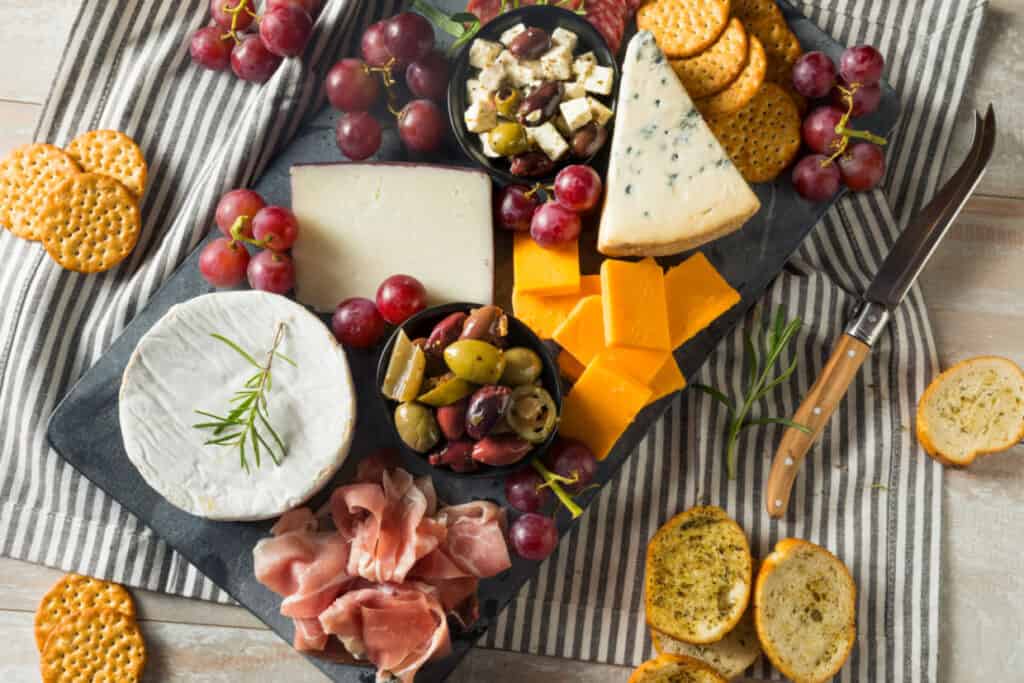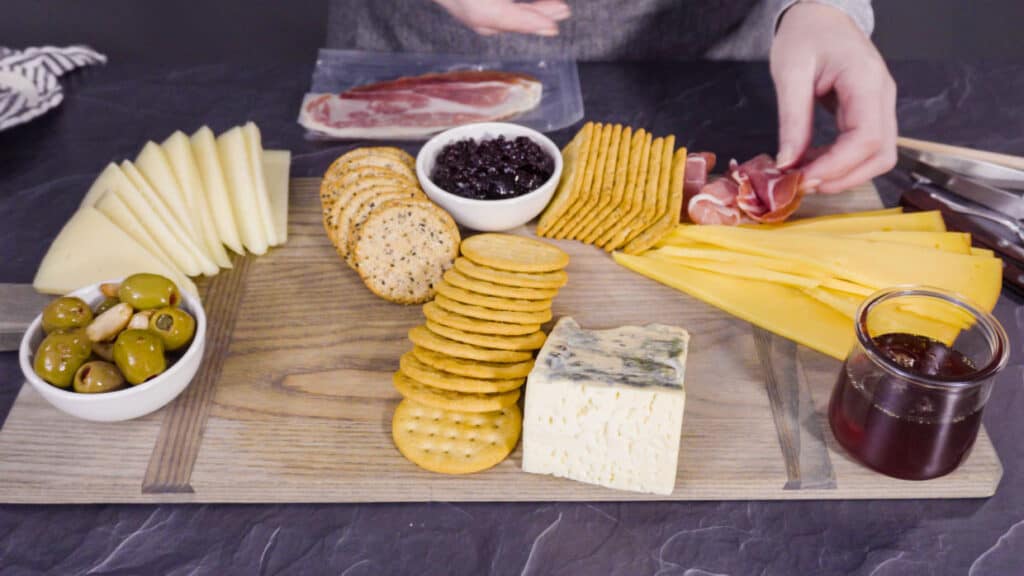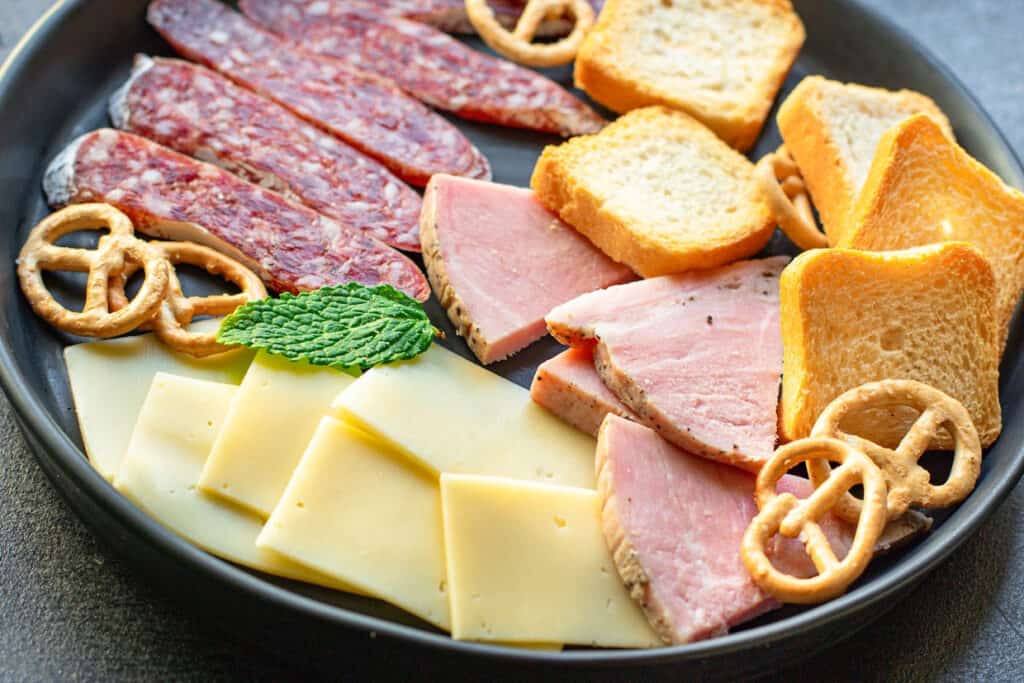What is charcuterie, and why is it so popular? From the old world to the modern day, the meat and cheese board has been a popular party staple and a delectable culinary experience. What could be better than an assortment of bite-sized nibbles displayed like a piece of art that you can easily make at home?

Charcuterie (shaar – koo – tr – ee) is a 15th-century French term that roughly translates to “cooked flesh.” Before refrigeration, curing meat was a necessity, and pork products were made into sausages, ham, pates and terrines. So charcuterie simply means cured meat.
Today, charcuterie boards, also known as meat and cheese boards, have become popular because they are so easy to make and are very versatile. There are many options for making a board, from adding high-end luxury foods to your favorite summer Quick Pickles. Or you can make a casual board like this Parmesan Cheese Charcuterie. That’s the beauty of a charcuterie; you can make it any way you want, so have fun and be creative.
To be a true charcuterie board, there needs to be cured meat on it, and fortunately, there is such a wide variety of meats to choose from.
What goes on a charcuterie board?
You get to determine what to serve on your board, but here are suggestions you can mix and match. The key to making a visually appealing board is to add variety, color and texture.
Meats: These are the stars of the board, so choose a mix of different cured meat products like salami, prosciutto, ham, cured sausages or Soppressata. You can be creative and add an assortment of Air Fryer Bacon Appetizers to your board.
FDL’S 75 Best Bites

Our cookbook with 75 tasty recipes will be your go-to kitchen companion for easy dinners with ad-free recipes right at your fingertips. Crafted by experienced chefs and recipe developers, this collection offers a treasure trove of tried-and-true dishes that make mealtime a breeze.
Get the Recipe: FDL’S 75 Best Bites
Cheeses: Add a variety of mild-and sharp-flavored cheeses that are soft, semi-soft and crumbly, and don’t forget the hard cheeses. Go for cow, sheep and goat milk cheeses for different flavors.
Savory component: This should complement the meat and cheese, such as pickles, nuts of all types, spreads, fresh vegetables, mustard or a dip like this Lemon Baked Ricotta.
Bread and crackers: Use a variety of crispy crostini, breadsticks and crackers, and why not add some Cheese Crackers to go along with the cheeses on the board? Different types of bread, like sourdough, rye or fruited bread are always a good choice, and baguette slices are the perfect size to add to the board.
“I love charcuterie boards because they are the easiest way to please a crowd in one simple, yet stunningly beautiful presentation. Make a cuisine theme like Mexican or Greek, find seasonal inspiration with fresh ingredients or pull out all the stops for a special holiday. You can even make a sweet dessert board! There are so many ways to mix and match flavors to find fun options that suite a variety of tastes. “
— Jessica Haggard, Easy Homemade Life
How to build a charcuterie board
With just a few simple steps, you can create your own edible work of art. But first, determine how many people you are serving so you have enough food and end up with a pretty presentation.
Essential items for serving
Boards, platters and more: Typically, a wooden board is used to hold the food, but so many other items will work, like a platter, trays, baking sheets, pieces of slate, marble tiles or cutting boards. Your options are limitless.
Ramekins and bowls: Jams, honey, spreads, dip, olives and pickles should go in bowls. But feel free to add other foods like nuts or other small items that can get lost among the meat and cheeses.
Cheese knives, spoons, and forks: Supply serrated or forked knives to cut blocks of cheese or pick up pieces of cheese. Small spoons and forks are needed for food in bowls for serving.
Putting the board altogether
There are no hard-set rules; just have fun because whatever you create will be delicious.

- Add the large elements such as the meats, cheese and bowls first
- Place the hard cheeses on the outside of the board
- Make sure you have a mix of color and texture
- Plan on 1 to 2 ounces of sliced meat per person
- Slice the meat thin so it can be easily folded and layered; thin is easier to eat.
- Add some ambiance to the board with a candle or edible flowers
- Add in-season fruits, such as cherries in spring, strawberries in summer, apple slices in the fall and mandarin segments in the winter.
Serve your charcuterie board for all seasons, holidays and themes. Here is some inspiration to get you started.
Make a Spanish-inspired board by adding chorizo, Carne seca and Serrano ham. For the cheese, add manchego, Chipotle cheese and queso fresco. Add Jicama sticks and radishes for a nice crunchy element. Figs and dried apricots are always a nice addition, along with Marcona almonds.
Game day boards are always popular. Think about what is served at a ballpark, such as sausages and bacon-wrapped hot dogs. Add beer nuts, peanuts and pretzels with a beer cheese dip.
4th of July means picnics and parties, so build a board around all things red, white and blue. Select the cured meats, cut star-shaped cheese slices and add blue corn chips. Blueberries, strawberries and a handful of ruby chocolates will add patriotic colors for the perfect celebration board.
Pack it up: You can take your board on a picnic or take it for a seaside getaway snack.
The one-serving board: Make a meat and cheese board just for you. Use a dinner plate and add your favorite salami, slices of ham, tangy cheese and some crispy crackers. Sounds delicious.
Make ahead for those busy days
You can make the whole board, wrap it with plastic and store it in the refrigerator. Add the bread, crackers and nuts when ready to serve.
What if you can’t fit the board in the fridge? Just slice the meat, cheese, and bread, then wrap them up. Put dips and spreads in bowls and cover them with plastic wrap. Wash and prepare the fruits to have ready. Refrigerate the perishable items. All of this prep work will make it easy to assemble your board right before serving time.
How long can a charcuterie board sit out?
Because you have meat and cheese on the board, there is a time limitation to leaving your board out to avoid spoilage. Two hours is the maximum; if it is summer or a particularly hot day, one hour is the maximum.
Can you think of an easier way to serve a tasty spread of many delectable ingredients? Next time you are entertaining guests, treat them to a gourmet spread of meat, cheeses and all of the flavorful sides. And the fun thing about making a charcuterie board is each one will be a unique creation.
Jere Cassidy is the writer and recipe developer behind the blog One Hot Oven. A passion for all things food-related led her to culinary school to expand on her baking skills and now to sharing easy recipes for all home cooks and bakers of all skill levels. When not in the kitchen, Jere’ likes to travel far and wide to find delicious food.
